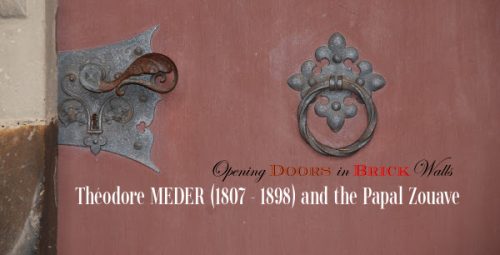Today would have been my father-in-law Marcel MEDER‘s 95th birthday. When I began researching our family history in 1995 my father-in-law was the one who helped me read the old handwriting in the documents I obtained from the records offices I visited in different towns in Luxembourg. He died too soon in 1996, less than two months before his 70th birthday.
In March 2015, I wrote about his great-grandparents Théodore MEDER (1807-1898) and Susanna REIFFER (1808-1877), a couple with a dozen children.
In previous posts for the family groups in Luxembourg, I concentrated on the birth and marriage records of the children. For the MEDER-REIFFER family, I tried something different. I used pink and blue boxes for the children, adding footnote links for their birth, marriage, and death records to the very long source list at the end of the post. Instead of discussing the birth and/or marriage records, I chose to focus on the census records of the family.
The Luxembourg Census
The census in Luxembourg was taken every three or so years. At FamilySearch there are 1,115,931 census images available for these years: 1843, 1846, 1847, 1849, 1851, 1852, 1855, 1858, 1861, 1864, 1867, 1871, 1875, 1880, 1885, 1887, 1890, 1895 and 1900.
Théodore MEDER should have been found in every single year the census was taken except for 1900 as he lived from 1807 to 1898.
I went through the entire 1871 census collection for Diekirch and did not find Théodore, Susanna, and their youngest daughter Catherine. Their married sons were found. Their married daughters, however, still need to be looked into.
The missing 1871 census listing is not the focus of this post.
After the death of his wife in 18771 and the first census following her death in 18802, Théodore went missing in 1885, 1887. 1890, and 1895.
Théodore was a widower for 22 years and may have spent some time in the local hospital before his death. This was known as when he died at three o’clock in the morning on 29 July 1898 his death was reported by Dominik ZENNER, the 64 years old overseer in the hospital (Aufseher im Spital) in Diekirch. The overseer stated that the death occurred in the hospital.3
Notes to myself and how my sister uses them
I share my GEDCOM file on GeneaLux.Net, a sub-site reserved for members of my genealogy society Luxracines. Earlier this month my sister, who also does genealogy and is a member of Luxracines, ran across Théodore’s 1885 census listing by accident.
Recognizing the surname, she checked my tree as she knows I keep notes to myself about the records I’m searching for. With the information on where he was found in 1885, she went on to successfully find him in the same place in 1887, 1890, and 1895.
Where did she find Théodore? In Diekirch, in the hospital where he was known to have died, in all four census years.
The Hospital of Diekirch
Rob Deltgen, the compiler of the family book for Diekirch, wrote about the hospital of Diekirch: “Offiziel wurde 1882 mit dem Bau des Hospitals begonnen, vorher existierte jedoch auch ein Bürgerhospital.” The construction of the hospital officially began in 1882, but before that, there was also a community hospital.4
In the center of town, the area around the church and judicial building is called ob der Klouster by the older generations of Diekirch. Behind the church, in the rue de l’Hôpital, is the rest home run by the nuns of the Congregation of the Sisters of Saint Elisabeth.
Théodore MEDER in the census
In 1885 Théodore was in pflege or in care at the hospital run by Catholic nuns. He had no occupation and was living on support or von unterstützung lebend. He was listed a few lines below Dominique ZENNER, Krankenwärter (nurse) in the hospital.5
On 1 February 1887, in the Klosterstrasse, the Abbess Généviève BOVÉ, as in 1885, headed the list of nuns who cared for the patients. The patients’ names were listed on the census page and then crossed out. Dominique ZENNER was listed as a nurse, two lines above Théodore whose name was marked out.6
On 1 December 1890, the street name was hinter dem Kloster or behind the convent. Abbess BOVÉ was still head of the convent. Dominique ZENNER is listed on line 18 and Théodore on line 20. Dominique’s occupation was Krankenwärter (nurse) and Théodore was living from support.7
By 2 December 1895, the hospital had grown. Personnel and patients were enumerated on five pages. The information included the number of years each had been at the establishment. The persons living the longest at the hospital were Pauline SCHROELL (line 33), Théodore MEDER (line 62), and Dominique ZENNER (line 67). All three had been there for 12 years, likely since the hospital had been built. Dominique was still working as a nurse, likely overseeing the men’s ward.8
Dominik, a Papal Zouave
Dominique ZENNER, as noted earlier, was the informant on the civil death record of Théodore MEDER. His name was used to learn more about the hospital. Searches, however, brought up more interesting information about the life of Dominique or Dominik as he was known by those he worked with him in the hospital.

The Zuavi Pontifici or Papal Zouaves were an infantry battalion and later a regiment dedicated to defending the Papal States. Young unmarried Roman Catholic men volunteered to assist Pope Pius IX in his struggle against the Italian unificationist.
Dominik ZENNER (1834-1924) worked as a nurse during the cholera epidemic of 1866 in Luxembourg. At the age of 34, he crossed the Alps to fight for the freedom of the Papal States in the ranks of the Papal Zouaves. Soon after his arrival, he contracted cholera but after several months was cured and able to leave the hospital. In 1869 he visited his homeland but returned to his military duties. In 1870 he was taken prisoner at Porta Pia by the Garbaldians. He received the papal blessing from Pope Pius IX from the loggia of the Saint Peter’s Church along with 1200 of his fellow prisoners. In October 1870 he was released to his homeland where he devoted himself to nursing the sick in the Diekirch hospital until his death.9
On 4 May 1920, Zenner celebrated his military jubilee with his brothers-in-arms Wilhelm LEYDER from Eppeldorf and Peter KIEFFER from Wiltz in the monastery of Diekirch. Her Royal Highness, CHARLOTTE, Grand Duchess of Luxembourg presented the jubilarians with the Silver Medal of the Grand Ducal Order of the Crown of Oak. At the same time, they received from the Archbishop of Luxembourg, Mgr. Pierre NOMMESCH the Pontifical Order Pro Ecclesia and Pontifice awarded by Pope Benedikt XV. It was pinned on their chests beside the Pontifical Medal Bene Merenti they had already received from Pope Leo XIII.10, 11, 12
Thank you to my sister
I’d like to thank my sister for keeping an eye out for records I’ve been unable to find and for letting me know when she finds them. Also, for unknowingly helping me to learn more about the history of the people of Luxembourg. I knew little of the Zuavi Pontifici and found interesting articles in the Luxembourg newspapers about the men who served.
As for Théodore and his nurse Dominik, did a friendship develop between the two as one was cared for by the other? Did Théodore know of Dominik’s military service? Did Dominik share stories of his adventures fighting for the freedom of the Papal States? What was it like for Théodore, who had spent most of his life working as a day laborer and shepherd, to live in an establishment for the last 15 years of his life run by women?
© 2021, copyright Cathy Meder-Dempsey. All rights reserved.
- Luxembourg, Registres d’état civil, 1662-1941 (images), FamilySearch (original records at Luxembourg National Archives, Plateau du Saint-Esprit, Luxembourg), Diekirch > Décès 1825-1890 > image 1066 of 1358. 1877 Death Record No. 58. (https://familysearch.org/pal:/MM9.3.1/TH-267-12147-166176-67?cc=1709358&wc=M9M6-2NH:n538876208 : accessed 01 Apr 2013). ↩
- Luxembourg, Volkszählungen 1843-1900 (images), FamilySearch (original records at Luxembourg National Archives, Plateau du Saint-Esprit, Luxembourg), Diekirch > 1880 > image 321 of 1562. Meder-Faber household No. 85 (https://familysearch.org/pal:/MM9.3.1/TH-1951-32389-5935-92?cc=2037957&wc=M5GS-GPL:345999901,345872201 : accessed 7 January 2015). See images 320 and 322 for the front and back of the census sheet. ↩
- Luxembourg Civil Records, Diekirch > Mariages 1895-1923 Décès 1895-1902 > image 550 of 661. 1898 Death Record No. 53. (https://familysearch.org/pal:/MM9.3.1/TH-1951-32038-1425-70?cc=1709358&wc=M9M6-2NF:21518491 : accessed 17 Feb 2013). ↩
- Rob Deltgen, Familienbuch Der Gemeinde Diekirch, published as part of the 750th anniversary of the city of Diekirch in 2010, page 6. ↩
- Luxembourg Census 1843-1900, Diekirch > 1885 > image 1523 of 1613. line 20. 1885 Zählungsliste No. 165a. (https://familysearch.org/ark:/61903/3:1:3QS7-L971-K3XG?cc=2037957&wc=M5G7-W38%3A345999901%2C345873701 : accessed 26 September 2021). ↩
- Ibid., Diekirch > 1887 > image 82 of 1594, line 4. 1887 Zählungsliste No. 37. (https://familysearch.org/ark:/61903/3:1:3QS7-8971-PS1Q?cc=2037957&wc=M5G4-3YM%3A345999901%2C345875201 : accessed 26 September 2021). Note: The nuns, servants, and patients being cared for were listed on Zählungsliste 36 and 37. All entries for patients were marked out. ↩
- Ibid., Diekirch > 1890 > image 357 of 1663, line 20. 1890 Zählungslist No. 36a. (https://familysearch.org/ark:/61903/3:1:3QS7-L971-PW7C?cc=2037957&wc=M5GZ-N36%3A345999901%2C345876401 : accessed 26 September 2021). ↩
- Ibid., Diekirch > 1895 (n 1432) > image 34 of 590, line 62. 1895 Zählungsliste No. 87d. (https://familysearch.org/ark:/61903/3:1:3QSQ-G971-RKJ4?cc=2037957&wc=M5GX-923%3A345999901%2C346457001 : accessed 26 September 2021). ↩
- Luxemburger Wort, 1924. Jg., nº 17 (17.01.1924), p. 3. Digitized by the National Library of Luxembourg, (https://persist.lu/ark:70795/9zv6n0/pages/3/articles/DTL42 : accessed 25 September 2021) ↩
- Escher Tageblatt, 1920. Jg., nº 106 (07.05.1920), p. 3. Digitized by the National Library of Luxembourg, (https://persist.lu/ark:70795/s79jff/pages/3/articles/DTL40 : accessed 25 September 2021) ↩
- Avis Mort. 6 Page 3. In: Luxemburger Wort, 1924. Jg., nº 17 (17.01.1924), p. 3. Digitized by the National Library of Luxembourg, (https://persist.lu/ark:70795/9zv6n0/pages/3/articles/DTL219 : accessed 25 September 2021) ↩
- Obermosel-Zeitung, 44. Jg., nº 282 (05.12.1924), p. 3. Digitized by the National Library of Luxembourg, (https://persist.lu/ark:70795/wtjk7b/pages/3/articles/DTL45 : accessed 25 September 2021) ↩






Censuses every 3 years – I am SO jealous!! Theodore led an interesting life and what fun t have a sibling helping you.
LikeLiked by 1 person
Don’t be too jealous, Linda. They aren’t indexed. The later years have built in control lists that point the the record number. So browse, browse, browse. Thank you for stopping by, Linda.
LikeLike
What an interesting and informative post. Loved the history lesson. Great job ‘sister’ for finding those records and adding to your families story 🙂
LikeLiked by 1 person
Thank you, Sharon. I have a few more things she’s found and need to get around to working on. Too much to do and so little time. 😉
LikeLiked by 1 person
Cathy, What a wonderful tribute to your father-in-law, who appears to have left us too soon. Kudos to your sister! So which is worse, having records that aren’t indexed or not having them at all? I choose unindexed records! Great read! Thanks,
Brian
LikeLiked by 1 person
Three times thank you, Brian. You know I found the best information in the unindexed records!
LikeLike
How lucky you are to have a sibling who shares your passion—and how generous of her to keep a look out for those on your tree.
For me the lingering question is—what was wrong with Theodore that kept him in the hospital for 15 years? I can’t imagine any medical condition that would have kept him there for that long. Is there any indication?
LikeLiked by 1 person
I never expected any of my siblings to become interested in genealogy and am happy that she shares my passion.
In 1880, when Théodore had been widowed for 3 years, he was living with his youngest son and his family. He was 73 and his son Franz’s family was growing. The nuns of the Congregation of the Sisters of Saint Elisabeth today run the elderly care center. I suspect Théodore was one of their earliest clients. I doubt that he had a medical condition that required constant attention since he lived to the age of 91. None of his siblings or his children lived this long. Thank you, Amy.
LikeLiked by 1 person
So it was more like what we today (in the US at least) call assisted living than a hospital, it sounds. Or maybe like a nursing home at the end.
LikeLiked by 1 person
I think more like a nursing home. When medical care was centralized in a few of the larger cities, many of the hospitals in towns in Luxembourg became nursing homes as the nuns remained to care for the people who didn’t need constant medical attention.
LikeLiked by 1 person
That makes sense and seems quite progressive, given that it was the late 19th century.
LikeLiked by 1 person